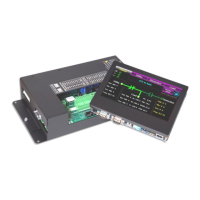Transfer output signals #14 AWG (2.5mm
2
)
Remote Start Contact for Engine Controls #14 AWG (2.5mm
2
)
NOTE: For long control wire runs or noisy electrical environments the control wires
should be twisted & shielded with a suitable drain wire. The shielded cable drain wire
must be grounded at one end only. The drain wire grounding location may vary as micro-
processor controllers generally exist at both ends (engine generator set & transfer
switch) and one may be more susceptible depending on the level of induced noise. The
most susceptible controller will require the shield ground point as close as possible to
the controller. Wire runs from 500ft to 1000ft should be twisted and shielded and
increased to #12 AWG where total loop resistance is greater than 5 ohms.
1
For distances exceeding 1000ft. (300m) consult Thomson Power Systems
2.11. REMOTE START CONTACT FIELD WIRING
Field wiring of a remote start contact from a transfer switch to a control panel should conform to
the following guidelines to avoid possible controller malfunction and/or damage.
2.8.1. Remote start contact wires (2 #14 AWG (2.5mm
2
)) should be run in a separate
conduit (ferromagnetic type) and in all cases separated from any AC wiring.
2.8.2. Avoid wiring near AC power cables to prevent pick-up of induced voltages.
2.8.3. An interposing relay may be required if field-wiring distance is excessively long
(i.e. greater than 1000 feet (300m)) and/or if a remote contact has a resistance
of greater than 5.0 ohms. In extremely noisy environments, the wire run lengths
indicated may not provide reliable operation and can only be corrected by the
use of an interposing relay. The interposing relay is generally installed at the
engine controls and utilizes DC power. It is strongly suggested that the ground
return wire of the interposing relay be used for the interface to the TSC 900
remote start contact, this will ensure integrity of the DC power supply to the
engine generator set controls in the event of a shorted or grounded wire remote
start interface wire.
2.8.4. The remote start contact provided is voltage free (i.e. dry contact). Exposing the
remote start contact to voltage or current levels in excess of its rating will damage
the transfer controller.

